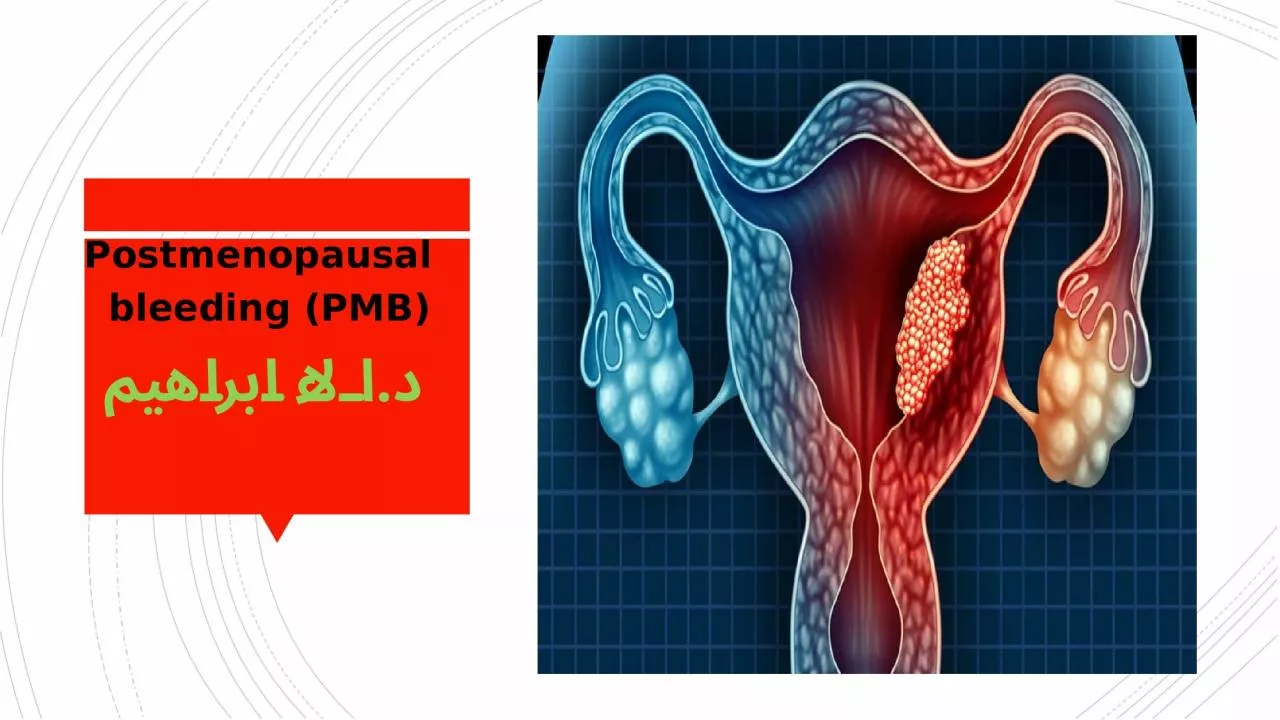

دالاء ابراهيم Objective Definition of PMB Causes of PMB Stepwise approach to PMB Management Definition Is vaginal bleeding that occurs a year or more after your last menstrual period The bleeding can be light spotting or heavy ID: 919782
Download Presentation The PPT/PDF document "Postmenopausal bleeding (PMB)" is the property of its rightful owner. Permission is granted to download and print the materials on this web site for personal, non-commercial use only, and to display it on your personal computer provided you do not modify the materials and that you retain all copyright notices contained in the materials. By downloading content from our website, you accept the terms of this agreement.
Slide1
Postmenopausal bleeding (PMB)د.الاء ابراهيم
Slide2Objective:Definition of PMB.Causes of PMB.Stepwise approach to PMB.Management.
Slide3Definition:Is vaginal bleeding that occurs a year or more after your last menstrual period. The bleeding can be light (spotting) or heavy. Occurs in up to 10% women over 55yrs.The mean age of menopause is variable but usually is 51 years old.
Slide4What causes postmenopausal bleeding?The most common causes of bleeding or spotting after menopause include:Endometrial or vaginal atrophy (lining of the uterus or vagina becomes thin and dry) 60-80 % as it is the most common cause.Cervical polyp is the second common cause.Hormone replacement therapy (HRT) (estrogen and progesterone supplements that decrease some menopausal symptoms).Endometrial cancer
10% as
90%
of cases presents with PMB
Type 1; exposure to unopposed estrogen, presence of risk factors such as obesity,
nulliparity
, diabetes, and
hyperestrogenisim
.
Type 2; not associated with risk factors, elderly , thin, poorer prognosis.
Endometrial hyperplasia 5-10%.
Uterine polyps.
Cervical cancer.
Cervicitis or
endometritis
.
Idiopathic cause
; as 10-15 % of cases no evident cause was found, therefore it is necessary to look for blood in stool or urine especially if the source of bleeding unclear.
Slide5Slide6Slide7Step wise approach to PMB:How do you know the cause of postmenopausal bleeding?Identifying the cause of the bleeding can include the following:History: Duration and severityPattern of bleeding; one off bleed versus regular bleeding.Associated symptomsHormonal treatmentPast medical and surgical history.Family history of colorectal, endometrial, other cancers associated with heredetriary non-polyposis colorectal cancer lynch-2 syndrome
Identify risk factors
for endometrial cancers;
Slide8Identify risk factors for endometrial cancers:
Slide9Slide10Clinical examination: obesity, pallor, thyroid gland assessment, cachexia.Abdominal and pelvic examination.Speculum examination.Bimanual examination.Cervical examination.Colposcopy.Cervical
cytology: pap smear to check the cervical cells.
Ultrasound
, usually using a vaginal approach, which may include the use of saline to make it easier to see any uterine polyps the endometrial thickness 5 mm in postmenopausal women need further investigation.
Outpatients
hysteroscopy
:
is the gold standard- allows direct
visualization
of uterine cavity, assessment of structural abnormalities, directed biopsy of specific lesions.
Indicated
when sampling cannot be performed due to cervical stenosis or when bleeding persists after negative biopsy.
Slide11Endometrial biopsy: Pipelle biopsy: more cost effective than D&C to diagnose endometrial cancer.Limitation : cancer may be missed when the it occupies <50 % of the surface area.•in this procedure, your healthcare provider gently slides a small, straw-like tube into the uterus to collect cells to see if they are abnormal. This is done in the office and can cause come cramping.•Inconclusive endometrial biopsy in
16%
due to technical issue or insufficient material, in 20% of cases the pre-malignant and malignant cases are
found
during the subsequent follow up.
Slide12Management: General treatment:Rapid restoration of blood volume and vital parameters if the bleeding is excessive with hospitalization.
Slide13Treatment:Treatment depends on what’s the cause of bleeding:•Cervical polyp: need to be removed.•Vaginal atrophy; need estrogen cream or pessary estrogen daily for 2 weeks then once- twice weekly for maintenance.•Endometrial
hyperplasia
; depending on the type of hyperplasia either no treatment, hormonal (tablets, or Intrauterine system) or total hysterectomy.
•
Endometrial
cancer treatment
: Stage 1 TAH + BSO, Stage 2 lymph node dissection, adjuvant chemotherapy, radio therapy.
•
Asymptomatic
thickened endometrium
:
prevalence
is 10-17%
of
PMB.
Need
no trigger additional evaluation unless significant comorbid risk factors are present.
•
Recurrent
PMB
: re-presentation of bleeding less than 12
months. perform
hysteroscopy or saline infusion sonography if last evaluation of the women did not involve these.
Slide14